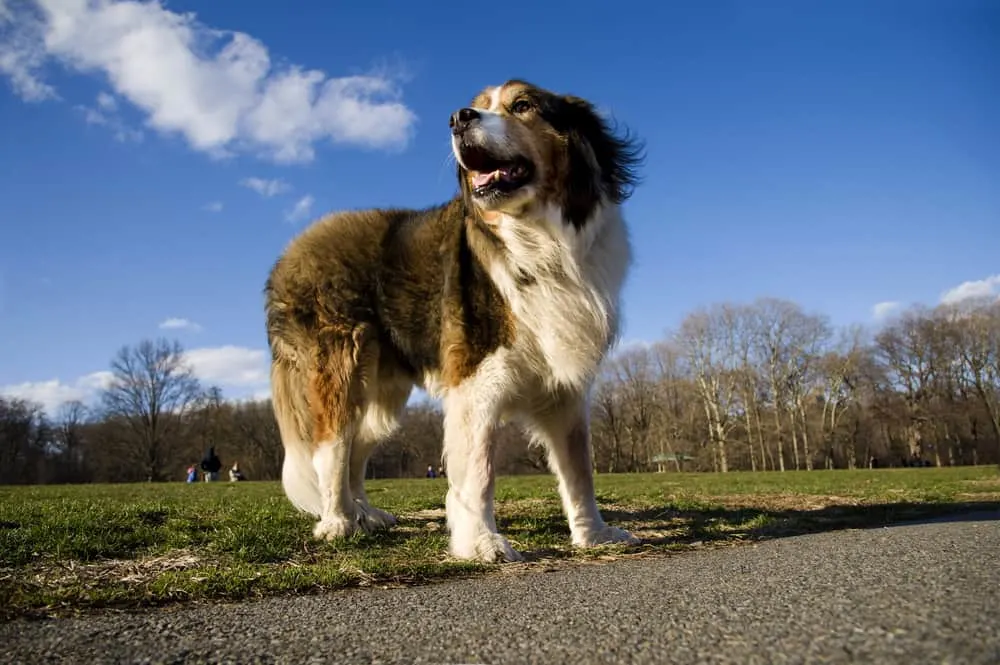St Bernard German Shepherd Mix: Meet The Impressive Saint Shepherd!
Do you want a sweet laid-back companion dog who’s large enough to ward off evil intent without having to attack?
Do you like the looks of a guard dog but don’t want the heavy commitment to exercise for a German Shepherd?
Should you consider a St Bernard German Shepherd mix? What does owning a German Shepherd Saint Bernard mix, or Saint Shepherd, entail?
To gain perspective on how a hybrid puppy might look and act, information about the parent breeds is needed: historical purpose, size, appearance, temperament, exercise requirements, and pet and guard dog qualities.
Looking at what a number of previous litters produced will help give you a better understanding of Saint Shepherd.
St Bernard German Shepherd Mix: Breed Characteristics At A Glance
| Height | Weight | Appearance | Coat | Health | Family Friendly? | Temperament | Training & Exercise |
|---|---|---|---|---|---|---|---|
| 25 - 28 inches tall on average | 85 - 140 lbs on average | Since these are both large dogs, the mix will be considered large or even giant. Can weigh up to 150 pounds with a large head, floppy ears, dark brown eyes, and a short to medium muzzle with a black nose. They have thick muscular bodies, straighter backs than GSDs, big feet, and arched toes. | Thick double coat that insulates well for cold weather, but can cause overheating in warmer climates. Prone to shedding so regular brushing will be needed. The head is typically dark brown or black, but their bodies can range from white, brown, & black to white & brown to black & brown. | Lifespan: 10-14 years on average. Primary health concerns include: Hip & Elbow Dysplasia, Renal Cystadenocarcinoma and Nodular Dermatofibrosis, Dilated Cardiomyopathy (DCM), Gastric Dilation Volvulus (GDV) or Bloat. | Yes, but still needs proper training & socialization. Saint Shepherds can be great family dogs, guard dogs, and can get along well with children. | Friendly, outgoing, laid back personality. Should get along with children & other dogs. Very obedient so they should be easily trainable. | Relatively high exercise requirements. One hour of daily exercise at minimum is ideal to limit destructive behaviors. Should ideally be socialized from a young age, although ongoing training is recommended. |
Saint Shepherd: Guard Dog Or Rescue Canine?
German Shepherds began as bands of herding dogs across the plains of Germany in the 1850s.
Max von Stephanitz, once a captain of the cavalry, was interested in developing an ideal working dog who could do more than herd sheep.
Stephanitz chose a show dog named Hektor Linksrhein as the perfect representative, changed the animal’s name to Horand von Grafrath, and proceeded to create the German Shepherd breed in 1899.
St Bernard German Shepherd Mix
Stephanitz invested years of work into generations of inbreeding, linebreeding, and culling. This produced a dog that still has a specific and recognizable form, versatility, and beauty.
Saint Bernard, named for the Augustine monk St. Bernard of Menthon, according to Smithsonian Magazine, originated in the Alps around 1665.
Developed by monks, the Saint Bernard dog was both a loyal pet and a guard dog along the Great Saint Bernard Pass.
Forbearers of St. Bernard included Asiatic mastiff types that the early Romans brought with them.
Later influences came from Newfoundland in some lines and the Great Dane, Great Pyrenees, Swiss Mountain Dog, and Tibetan Mastiff.
Since the areas where the dogs lived were at elevations of 8,000 feet, the St. Bernards found use in helping trekkers navigate the passes.
The dogs accompanied marronniers, or special servants, assigned the task of guiding foot travelers across the mountains.
Saint Bernards would later realize their true calling, rescuing victims buried under snow. Saint Bernards are as recognizable as German Shepherds although not as popular.
Saint Shepherds joined the designer dog ranks in the 2000s among dog lovers who wanted to create an ideal companion who would also have moderate guard potential.
What Is The Appearance Of A St Bernard German Shepherd Mix?
Size
German Shepherd females are 22 to 24 inches tall, while males are 24 to 26 inches in height.
The breed standard, according to the AKC, doesn’t specify weight requirements, but German Shepherds are balanced according to their height, typically weighing from 55 to just over 100 pounds.
Saint Bernards are giant dogs. Females stand 26 to 31 inches tall at the shoulders, and males can be up to 35 inches. Saint Bernards weigh anywhere from 140 pounds to a staggering 260 pounds.
A Saint Shepherd isn’t as large as a Saint Bernard, but you still will be dealing with a very large dog.
German Shepherd Saint Bernard mix females are 25 to 28 inches tall and weigh 90 to 140 pounds. Males can range from 28 to 31 inches tall and can weigh over 150 pounds.
What is the general body type?
German Shepherds are medium-large dogs with lean frames. They’re elegant, confident, and strong.
They have a long snout with some squaring of the muzzle, a dome-shaped forehead, brown medium eyes with a slight slant, muscular lengthy limbs, and a rectangular back that slopes downward towards the bushy tail.
The Saint Bernard is a mastiff-type with a massive head and large-boned body. The muzzle tends to be deeper than it is long, and their eyes are brown, set forward, and deep.
They’ll have wrinkles and furrows on the forehead, a broad chest, large shoulders, and a strong back that slopes slightly from the shoulders to a slightly curved tail.
They give an impression of power.
A St. Shepherd has the large head of a Saint Bernard, with a moderation of the jowls, and lengthening of the muzzle.
As a result, most hybrids don’t drool as much as Saint Bernards. Saint Shepherds usually have ears that hang down, roughly triangular like a Saint Bernard’s.
Their legs and body are strong and their backs are straight or slightly sloping. Occasionally, the German Shepherd St Bernard mix will have relatively large ears that stand up.
Will your Saint Shepherd have unusual colors?
Not all Shepherds are black and tan, and not every Saint Bernard is the stereotypical tricolor brown and white with black.
The German Shepherd can be red and tan or blue and tan. They can also be solid red, black, tan, blue, or white.
The AKC specifies that all Saint Bernards must have white on the chest, feet, the tip of the tail, and neck.
Colored patches can be brindle or any shade of red. Show judges and the public alike prefer dogs with dark masks on their faces.
A black facial mask is a very common trait among German Shepherd Saint Bernard offspring.
Most of the hybrids are white and brown, red, fawn, or sable. Saint Shepherds can also be tricolor, like a Saint Bernard, or black and white pied.
Are There Any Special Grooming Considerations?
German Shepherds have three possible coat types and Saint Bernards two.
The Shepherd can have long or medium-short straight hair with a thick undercoat. The third coat type is long outer fur without an undercoat.
Saint Bernards come in a long or short-haired variety. Both coat types have a thick undercoat, and the outer guard hairs are usually straight to wavy.
Your Saint Shepherd will have a dense undercoat with medium-long straight outer hairs. You’ll need to brush it at least every other day to prevent snarling and matting.
You should also plan on monthly bathing. To prevent the skin and coat from drying out, don’t bathe too frequently, use a mild shampoo designed for canines, and make sure to rinse off all the soap.
Check your dog’s ears frequently, especially if they are floppy. Clip nails as with any dog every four to six weeks.
The Saint Shepherd’s Heavy Coat Is Great For Winter
Your Saint Shepherd’s double coat will protect it from the frigid cold, just like both parent breeds.
However, as with the Saint Bernard, the Shepherd hybrid is susceptible to overheating in the summer when temperatures head north of 85 or 90 degrees Fahrenheit.
They don’t insulate from the sun as well as the Shepherd does.
Measures you can take to help with the heat are setting up a mini pool or running a misting system or sprinklers.
Fresh water should always be available, regardless of the weather.
When it’s cold outside, make sure your dog still has access to shelter. Although the coat is water-resistant, additional precautions are needed to avoid sudden drops in their core temperature.
Shepherd-Saint Bernards Make Good Family Pets
Will your mix be good around children?
Saint Shepherds often inherit Saint Bernard’s good-naturedness towards kids.
However, you should limit the Shepherd Saint Bernard cross’ exposure to young children because of their size.
Do Saint Shepherds Get Along With Other Pets?
German Shepherds can be ‘dog aggressive’, but early socialization with a lot of exposure to other canids may lessen this tendency.
However, the combination of their independent working style and a brief history of dogfighting, makes it prudent to exercise caution when introducing German Shepherds to new dogs.
According to Dogtemperament.com, Saint Bernards get along with a variety of animals, including other dogs and even cats.
The Shepherd-Saint Bernard often inherits their social make-up from the Saint Bernard side, and as such they love to play.
Intelligence & Training

According to dogbreedslist.info, German Shepherds rank in the top three most intelligent dog breeds.
Saint Bernards rank in the mid-60s out of 137 dogs, near Old English Sheepdogs and Bull Terriers.
Although Saint Bernards may be a little stubborn due to their mastiff ancestry and require a few repetitions to learn certain commands, they’re generally eager to please.
Three components used to gauge canine intelligence are obedience, the job for which they were bred, and finding solutions to problems or solving puzzles.
An example of a job ranked high for intelligence is herding, which requires dogs to think.
Your Saint Shepherd will be a very intelligent and obedient dog.
Nevertheless, you need to begin training early as Saint Bernard mixes will become giant dogs and impossible to control if they’ve been allowed free reign for most of their lives.
A Saint Shepherd Is All The Guard Dog You Need
German Shepherd Saint Bernard mixes are in many ways ideal guard dogs. Their size alone is enough to deter trespassing, let alone break-ins or home invasions.
Saint Shepherds have a loud bellowing bark as well. Despite this, they aren’t quick to attack, reserving biting as a last resort.
What Health Concerns Should You Be Aware Of?
Shepherd Saint Bernard hybrids tend to live longer than their parents, but they can inherit several serious health problems. In parentheses is which breed can pass the problem to the mixed puppies.
Gastric Dilatation and Volvulus – GDV, not necessarily heritable, is a life-threatening problem that threatens any large dog with a deep chest as well as Dachshunds.
The stomach becomes bloated with gas and can rotate 180 degrees or more. Sometimes the spleen also twists.
Ectropion/Entropion (Saint Bernard) – In ectropion or entropion, the eyelids droop away from the eyes or roll inward, respectively.
Hip and Elbow Dysplasia (St. Bernard, GSD) – According to TopDog Health, the incidence of hip dysplasia in Saint Bernards might be as high as half of all tested dogs.
German Shepherds have a higher-than-average occurrence of elbow dysplasia as well.
Dilated Cardiomyopathy (Saint Bernard) – Along with Dobermans, Boxers, and Great Danes, St. Bernards are vulnerable to heart failure.
Dilatative cardiomyopathy is usually left-sided and leads to enlargement of the heart and thinning of the cardiac walls.
Cystadenocarcinoma and Nodular Dermatofibrosis (GSD) – A hereditary condition that causes skin tumors, uterine cancer, and changes in the kidneys.
Pannus (GSD) – Pannus is a disease that affects the cornea of the eye.
Rarely, your dog may become diagnosed with degenerative myelopathy (a progressive neurological and muscular disorder), perianal fistulas (draining tracts around the anus), hemophilia (blood clotting disorder), and decreased pancreatic enzymes – all diseases affecting the German Shepherd.
Saint Bernards only live for about 7 to 10 years, while German Shepherds can live 10 to 12 years.
Perhaps exhibiting slight hybrid vigor, Saint Shepherd can live 10 to 14 years, according to dogbreeds10.com.
How much exercise does the German Shepherd Saint Bernard need?
German Shepherds are highly active dogs with abundant energy and exceptional stamina levels.
With the mental stimulation they also require to remain emotionally balanced, Shepherds require 90 to 120 minutes of exercise and training per day.
On the contrary, sources like Dogtime recommend only moderate exercise for Saint Bernards.
The Saint Bernard puppy is prone to bone developmental disorders from rapid growth. Over exercise can exacerbate abnormal growth, pain, and discomfort.
Saint Bernard puppies still need to exercise to prevent problems associated with becoming overweight.
An exercise regimen should accommodate St. Bernard’s need for gradually increasing increments of exercise duration and intensity.
Ultimately, a Saint Bernard needs 30 to 60 minutes of exercise daily.
Saint Shepherds are between their two parents in exercise requirements and activity levels.
They’re moderately energetic and require about 45 to 75 minutes of daily exercise depending on how much they resemble the GSD.
You must always take into account the weather because your Saint Shepherd will be more heat-sensitive than a GSD.
Here are examples of what you can expect from a GSD Saint Bernard mix

These pups are typical Saint Shepherds. Most won’t have the classic color pattern of a Saint Bernard but will instead be fawn or sable, or varying degrees of reddish-brown.
This video illustrates the vast difference in size and appearance between Saint Bernards and German Shepherds, as well as a few of the color variations you can see in black and tan GSDs.
Although the professor at one point in the video questions Moose’s parenting, this dog could’ve been taken straight from the breed standard of Saint Shepherds.
Note the reddish-brown color with a black mask. Moose’s ears are quite reminiscent of a Saint Bernard’s.
The way Moose’s muzzle joins his face reminds you of a Shepherd but the wrinkles tell of mastiff-type bloodlines. Notice how friendly and comfortable he is.
This is most likely due to proper socialization and having loving owners.
He is a large Saint Shepherd with medium hair. His feet and the tip of his tail are white like a Saint Bernard. Many hybrids of this particular mix are taller and leaner than you might expect.
Our YouTube Video On The St Bernard German Shepherd Mix
Frequently Asked Questions
Are St Bernards aggressive?
In general, no, St. Bernards are not typically aggressive dogs. They are a well natured dog that is great in a family setting. They are known for their tolerance and patience, which is especially important if you have younger children.
However, while they are not typically aggressive in their nature, a non-aggressive dog is never a guarantee when purchasing. This is why training a dog is so important because it will help to ensure that your dog has the correct manners and temperament.
While a lot of people may be put off by the size of a St. Bernard, their size does not reflect their personality. They are often known as gentle giants because they are well natured.
When it comes to other animals in the household, again, St. Bernard’s are tolerant and accepting. They may potentially have some issues with dogs if they have experienced any negative interactions, but for the most part, they are not aggressive dogs.
Do St Bernard’s like to cuddle?
Yes, for the most part, St. Bernard loves to cuddle. While many people can be put off by their size, which can be understandable, they are very loving. They love to be around family members and enjoy receiving a fuss and cuddles.
While they are not a big attention seeking breed, they do enjoy being stroked. However, as with all dogs, St. Bernard’s do have individual personalities. Given this, while many do enjoy being cuddled, not all will.
If your dog prefers a belly rub or a head scratch, then you should do this instead of forcing your dog to cuddle. All dogs will show affection in their own individual way, which you should be aware of. The more you get to know your dog, the more you will understand what affection they prefer.
Are St Bernards easy to train?
Yes, St Bernard’s are quite an easy breed to train. This is because they are a dog that wants to please its owner. As a result of this, they do respond well to commands and instructions.
Training is such an important aspect to owning a dog, especially if you are a new dog owner. However, while they are an easy breed to train, you will need to ensure that you are putting in the time and effort required to train the dog correctly.
The more effort you put into training your dog, the better behaved, and obedient they will be on the whole. Given that they are calm dogs, they do have a lot of patience when they are being trained, which is positive. They are not as easily distracted in comparison to other breeds of dog.
The only thing to keep in mind is that some St Bernard’s can be quite stubborn. As a result, they may not do what is asked of them straight away. Stubbornness can make training slightly more difficult, and this will require patience and persistence from you, the owner.
Do shepherd mixes bark a lot?
While this will depend on the individual dog, typically shepherd mixes will bark a lot. This is because German shepherds are a breed that can be quite vocal. While this is not necessarily a negative thing, it can be off-putting for some people.
While they are more likely to bark in comparison to other mixes of dogs, it is possible to stop this from occurring. Though it will require more patience and persistence, you can train a German shepherd mix not to bark.
With mixed breeds, it is difficult to determine how a dog will act. This is because they have traits of two separate dog breeds. While German shepherds are a more vocal breed, if they are mixed with a breed that is not overly vocal, this can mean that their litter will be less vocal on the whole.
How big do German shepherd Saint Bernard mix get?
The size of a German Shepherd and Saint Bernard mix will vary depending on the size of both parents. While you can guesstimate, ultimately their size is down to the characteristics of both parents.
However, typically this mix will reach around 28 inches tall, though they can be smaller than this. This is fairly large, but not as large as a Saint Bernard. When looking at their weight, they will typically weigh anywhere from 85 to 140 pounds.
While this is an estimate, you may find that your mix will be slightly taller or smaller than this, due to its genetics.
































